| Spotlight
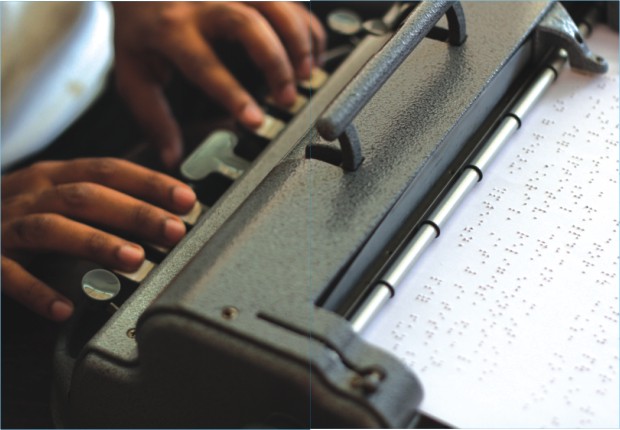
Braving the Barriers
Rakibul Hasan
Photo: Kazi Tahsin Agaz Apurbo
Mahbubur Rahman Rony, a Dhaka University (DU) student was running towards the DU Central Library along with some friends, rushing to meet a deadline. To finish the assignment, Rony and his friends have to face the agony of skimming through a number of books within a few hours. Just like his other classmates, Rony finds himself inundated with books, class notes and assignments just a few days ahead of the final exams, since Facebook and hangouts leave little time for him to study all through the semester. The only difference between Rony and his other friends is that he was born visually impaired and does not view the world like the others do. However, the barrier of visual impairment failed to hold him back. Presently doing his BA (honours) from the Department of English, University of Dhaka, Rony prepares himself for the exams, using the Resource Centre for the Visually Impaired Students at the Dhaka University Central Library.
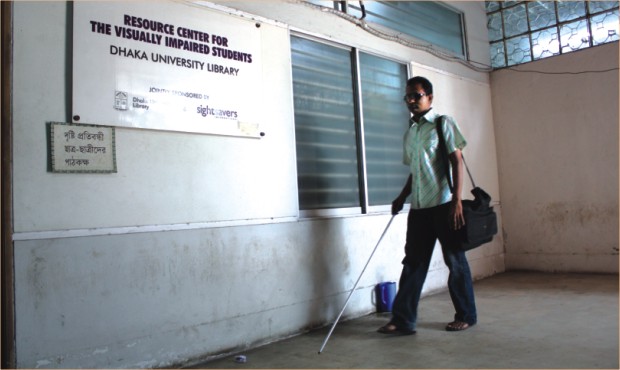
Visually imapired students can now prepare for their classes or do their assignments at
the Resource Centre for the Visually Impaired Students.
Located on the ground floor of the Administrative Building of the DU Central Library, The Resource Centre for the Visually Impaired Students is a unique place where DU students who are not able to see, can use library resources using specially designed study materials. Almost all the study materials in the resource centre are in Braille. The Braille system is a method that is globally used by visually impaired people to read and write. Each Braille character, or cell, is made up of six dot positions, arranged in the shape of a rectangle containing two columns of three dots each.
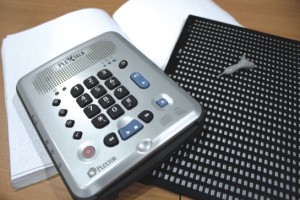 |
The study materials at the resource centre are specially designed
for the visually impaired students. |
With a view to assisting the visually impaired students studying at DU, the centre was established in the year 2007 through a joint initiative by the DU authority and Sight Savers International, an NGO that works for visually impaired students worldwide. Although, like most public university libraries, the Resource Centre for the Visually Impaired has its own set of limitations, it is helping out a number of visually impaired students with their academic activities, which was once considered near to impossible. Mir Arshedul Karim Sohel, the Section Officer at the DU resource centre for the Visually Impaired Students clarifies the objectives of the resource centre, “It's a resource centre of, for and by the visually impaired students.” Being a visually impaired person himself, Sohel understands perfectly the obstacles that a visually impaired student faces. “When I was a student, there was no such exclusive resource centre for the visually impaired students. So back then, the scenario was bleak and a very, very difficult one,” he says.
 |
At the resource centre the visually impaired students
can find a collection of Braille books. |
Screen reader software help the visually
impaired users in everyday tasks. |
The facilities at the resource centre include study materials like collections of books in Braille, Braille Perkins Typewriter, 27 lines Braille guide (a writing frame through which students can write in Braille), Braille stylus (a special pen to write in Braille) and an impressive collection of cassettes and CDs. The resource centre also contains a number of modern machineries which have made learning process much easier, for example computers with screen reader software installed in them, namely JAWS or the 'Job Access With Speech', which provides the users with access to the information displayed on the screen via text-to-speech or by means of a Braille display, also allowing users to perform comprehensive keyboard interaction with the computers. The library also boasts a scanner machine, Braille printer (an impact printer that renders text as tactile Braille cells), Plextalk Machine (a specialised machine where visually impaired students can record sound and listen from the audio), tape recorders and some other useful tools.

Students can write braille by the means of the braille stylus.
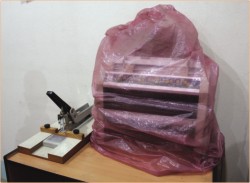 |
The braille printer at the resource centre that is currently out of order. |
The Resource Centre for the Visually Impaired is open six days a week from 9.30 am to 4.30 pm. Mahbubur Rahman Rony, the aforementioned student from the Department of English, shares his experience, “The best part about this resource centre is that it lets me stay in touch with all the visually impaired students at DU. I often feel left out as my friends head out to the central library for their projects or assignments. Now things have definitely changed. Another notable thing is that the staff members here are also visually impaired, which is why they have a better understanding about the problems that a visually impaired student suffers from."
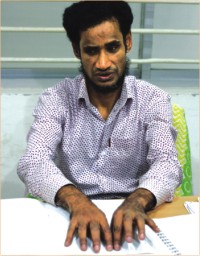 |
Mir Arshedul Karim Sohel, the Section Officer at the DU
resource centre for the Visually Impaired Students. |
Though the visually impaired students appreciate the facilities provided by the centre, according to them, the centre still leaves a lot to be desired for. "Presently, the resource centre is being crippled with certain limitations," adds Rony. "The number of Braille books at the resource centre is way less than sufficient. One of the major problems is that the only Braille printer at the resource centre has been out of order for quite a long time. In a nutshell, we want an informative library where the visually impaired students can meet up and complete their tasks with ease like any normal student.”
 |
The resource centre facilitates the visually impaired students
of DU to stay in touch with each other. |
Shahida Afroz, another visually impaired student from The Institute of Education and Research says, “My only hope is that the centre will bring an end to the adversities that visually impaired students in the University have to face. For example, to prepare for an exam, we have to collect notes from our classmates after, which we have to find someone to read them out so that we can record the audio. If a permanent reader is appointed in the resource centre then we will not have to go extra miles, and we can prepare for the exams whenever we want to.”
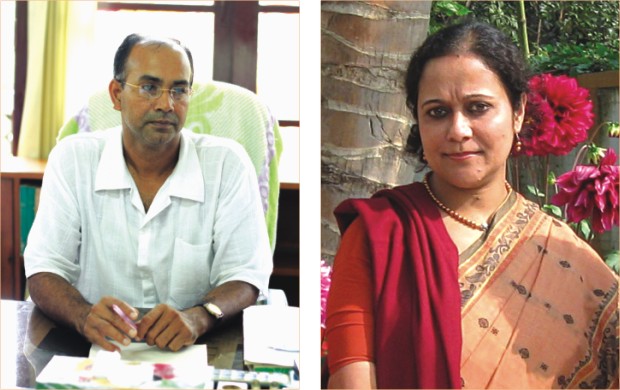 |
Professor Dr. M. Nasiruddin Munshi, Library
In-Charge of the Dhaka University Library. |
Mrs. Diba Hossain, Associate Professor,
Department of Special Education, IER. |
 |
Each braille character, or cell, is made up of six dot positions. |
Professor Dr. M. Nasiruddin Munshi, Library In-Charge of the Dhaka University Library, assures to resolve the problems within a short time. “Since its birth, the Resource Centre for the Visually Impaired Students has been assisting the visually impaired students of DU with all their academic activities. Here at the Dhaka University Library, we are trying to enrich the Resource Centre so that it can become more resourceful for these students,” he says. About the inoperative Braille printer, Professor Munshi says, “Braille printers are quite expensive to buy. It is difficult to acquire a new printer within the limited allocation of funds. We had requested some organisations working for visually impaired students, to repair the out-of-order printers but we did not get any response. We plan to purchase a new one in the coming fiscal year of the University.”

Students at the'Low vision Resource Centre' develop innovative study materials for the visually impaired students.
Another place of interest for the visually impaired students studying at DU is the 'Low Vision Resource Centre.' It is a place where the visually impaired or students with strained eyesight not only get to use study materials, but also receive training in developing materials for visually impaired persons of the society. Located on the third floor of the Institute of Education Research (IER), DU, both the visually impaired students as well as the regular students of Department of Special Education under IER who have completed their majors in the programme 'Specialisation on Visual Impairment', have to use the resource centre as part of their curriculum.
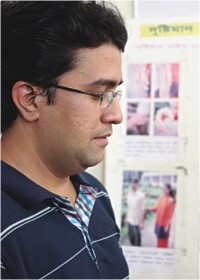 |
Shahriar Haider, Lecturer, Department
of Special Education, IER, DU. |
The resource centre was established through a joint initiative taken by Ms. Diba Hossain, Associate Professor at the Department of Special Education, IER, DU and the Sight Savers International. Shahriar Haider, a Lecturer at the Department of Special Education describes the activities of the Low Vision Resource Centre. “The resource centre is serving a two way purpose. It is enabling visually impaired students to carry out their educational activities more comfortably while at the same time, all students of the Department of Special Education, irrespective of being visually impaired or not, who have chosen 'Visual Impairment' as their major, are being trained at the centre as well,” says Haider
Students at the Low Vision Resource Centre get to learn about the use of different materials designed for the visually impaired students and also about developing new materials to bring innovation in teaching students with visual impairment. And there have been some worthwhile developments created by students, for example, a custom designed Counting Aid similar to an abacus as well as touch sensitive pictures, which would help visually impaired students with their education in school. Jannatul Ferdous, a student of Special Education and a regular user of the Low Vision Resource Centre says, “Though I have no problem with my eyesight, I have found the resource centre a wonderful place to acquire in depth knowledge in the field of visual impairment specialisation. With the training, one can come up with innovative ideas which may assist visually impaired members of society to overcome challenges that they deal with at every step in their lives.”
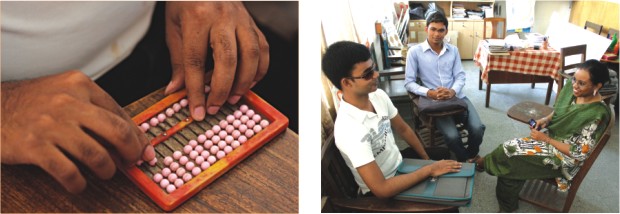 |
Abacus (a counting aid). |
The Low vision Resource Centre is a wonderful
place to acquire in-depth knowledge. |
Despite being challenged with several physical and social barriers, the visually impaired students studying at DU have refused to stray away from their dreams of pursuing higher education and having a career just like any other member of society. Places like the Resource Centre for the Visually Impaired Students or Low Vision Resource Centre are creating opportunities for these brave contenders, who might not be able see the world and all its treasures, but surely possess all the abilities to transform the world into a better one. |
Copyright (R) thedailystar.net 2011 |

